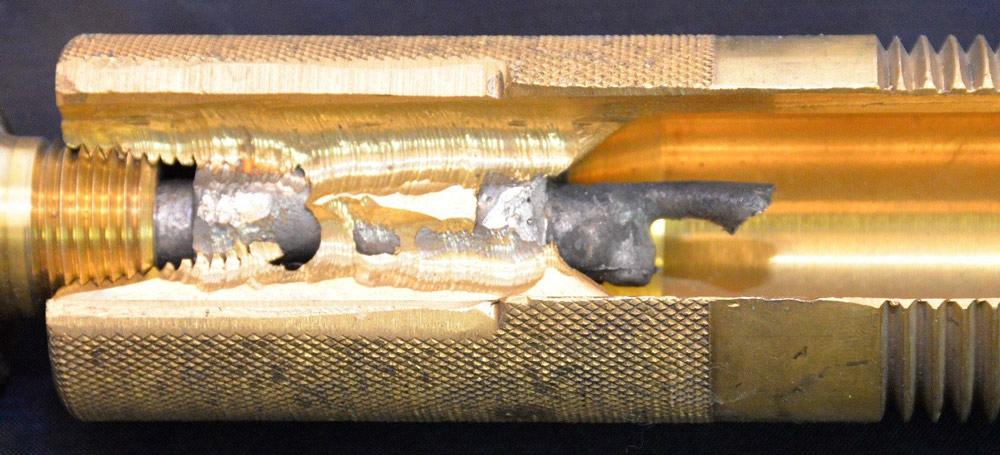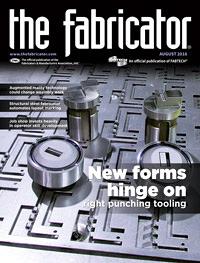- FMA
- The Fabricator
- FABTECH
- Canadian Metalworking
Categories
- Additive Manufacturing
- Aluminum Welding
- Arc Welding
- Assembly and Joining
- Automation and Robotics
- Bending and Forming
- Consumables
- Cutting and Weld Prep
- Electric Vehicles
- En Español
- Finishing
- Hydroforming
- Laser Cutting
- Laser Welding
- Machining
- Manufacturing Software
- Materials Handling
- Metals/Materials
- Oxyfuel Cutting
- Plasma Cutting
- Power Tools
- Punching and Other Holemaking
- Roll Forming
- Safety
- Sawing
- Shearing
- Shop Management
- Testing and Measuring
- Tube and Pipe Fabrication
- Tube and Pipe Production
- Waterjet Cutting
Industry Directory
Webcasts
Podcasts
FAB 40
Advertise
Subscribe
Account Login
Search
Staying safe while using oxyfuel torches
Does your shop have oxygen safety devices?
- By Dave Marquard and Kurt Tarkany
- August 3, 2016
- Article
- Oxyfuel Cutting

Figure 1
This image shows the thermal shutoff device (left) and the body (right). In typical operation, oxygen flows from the source through the thermal shutoff device, through the body, and out of the device.
Greg Cain, director of technical services for Oxylance, a manufacturer of exothermic cutting systems, Birmingham, Ala., has seen firsthand how an oxygen safety device prevented a near-miss accident—and the corresponding catastrophic consequences—in a large steel mill.
As an operator at the steel mill was lancing a tap hole in a ladle of molten metal, he inadvertently left the lance pipe in the slide gate. This caused the molten metal to run back down the lance pipe. In this case, the molten metal was stopped because the lance pipe had an oxygen safety feature in the form of a thermal shutoff antislag device. Heat from the molten metal activated the oxygen control valve, preventing the molten metal from leaving the pipe holder. If the oxygen control valve had not been in place, the operator could have been seriously burned and a plant fire could have ignited.
Cain was at the mill giving a safety training class when the plant manager approached him and showed him the safety device. It was evident that the thermal shutoff device worked and prevented what could have been a serious accident.
Oxylance followed up with its own investigation to determine why the near-miss accident happened. Cain found that a combination of ineffective operator training and operating error contributed to the situation. The mill has since changed its operator safety training.
As part of his investigation, Cain closely examined the oxygen safety device on the lance pipe to document exactly how it had worked in the field to prevent the accident. He had experience as a photographer in the U.S. Marine Corps, and his photographs helped to document just how the custom safety device did its job. His photos capture the inner workings of the device.
Figure 1 shows the path that the oxygen takes as it moves from the source to the torch. When material, such as molten metal, flows back into the system and into the device, the thermal shutoff device (left) is heat-activated (see Figure 2) and completely shuts down the flow of oxygen. That stops the reverse flow of material.
If the material is not blocked, the operator and the nearby work area are in danger. Figure 3 shows how molten metal can make its way to the oxygen source supply.
Flashback Arresters Provide the Protection
Closely allied with the oxygen safety device that worked so successfully at the steel mill as an arrester of slag intruding into a flow of oxygen is a flashback arrester. But rather than attaching to a lance, a flashback arrester is attached to regulators and torches used in welding and cutting operations.
Whereas steel mills commonly use slag arrester-type safety devices, manufacturers have not widely adopted the use of flashback arresters for use on their gas cylinders. In fact, research suggests that only about 15 percent of the potential market for this type of safety product—which takes into account 90 million gas cylinders in North America—is actually using the flashback arrester technology. It also should be noted that every compressed gas cylinder in the U.S. and Canada has a label that clearly states, “Use a backflow preventer in the gas system” or something similar. An example is shown in Figure 4. Government agencies, such as the Occupational Safety and Health Administration, have the power to enforce this requirement. These numbers fly in the face of the proven fact that these safety devices make working with oxygen safe on the shop floor by preventing a flashback of an explosive mixture of gases.
Just consider some of the other dangerous scenarios that could occur in a shop without flashback arresters. For example, gas processes such as heating, flame cutting, welding, and even purging are often used at pressures and flows that are either higher or lower than the equipment manufacturer’s instructions. This creates a hazardous reverse flow of gas and the potential for flashbacks in hoses and piping. In another example, gas equipment such as pipelines, regulators, and valves are rarely inspected on a regular basis or according to the equipment manufacturer’s instructions. Faulty equipment can lead to hazardous situations.
Flashback arresters are rarely deployed if the equipment is in good condition, maintained, and used properly. Unfortunately, in the real world mistakes happen to even experienced fabricators with new equipment, and flashback arresters can and do prevent injuries and fatalities. They prevent the reverse flow of gases, quench flashbacks and flame propagations down hoses and pipelines, and also have options to stop burnbacks. (The How Flashback Arresters Work sidebar provides a more detailed look at how the devices prevent these accidents.)
It is critical to have a formal inspection program because safety devices eventually wear out from use. They keep the shop safe at all times.
Getting the Word Out
In more than 30 countries, including the European Union, these types of safety devices are required by law. In the U.S. and Canada, gas and equipment manufacturers are dedicated to safety and self-regulation. Virtually all of the welding equipment manufacturers provide flashback arresters, and most Fortune 500 companies require their use.
The single largest reason that only about 10 to 15 percent of the market uses them is lack of awareness of the hazard of improper use of gas flame cutting and welding equipment. If more welders and managers knew how easy it is for even an experienced welder or gas user to cause a flashback or a reverse flow of hazardous gases, more companies would require them.
About the Authors
Dave Marquard
28825 Ranney Parkway
Cleveland, 44145
440-716-9960
Kurt Tarkany
Global Sales Manager
28825 Ranney Parkway
Cleveland, 44145
440-716-9960
Related Companies
subscribe now

The Fabricator is North America's leading magazine for the metal forming and fabricating industry. The magazine delivers the news, technical articles, and case histories that enable fabricators to do their jobs more efficiently. The Fabricator has served the industry since 1970.
start your free subscription- Stay connected from anywhere

Easily access valuable industry resources now with full access to the digital edition of The Fabricator.

Easily access valuable industry resources now with full access to the digital edition of The Welder.

Easily access valuable industry resources now with full access to the digital edition of The Tube and Pipe Journal.
- Podcasting
- Podcast:
- The Fabricator Podcast
- Published:
- 04/16/2024
- Running Time:
- 63:29
In this episode of The Fabricator Podcast, Caleb Chamberlain, co-founder and CEO of OSH Cut, discusses his company’s...
- Trending Articles
Capturing, recording equipment inspection data for FMEA

Tips for creating sheet metal tubes with perforations

Are two heads better than one in fiber laser cutting?

Supporting the metal fabricating industry through FMA

Omco Solar opens second Alabama manufacturing facility

- Industry Events
16th Annual Safety Conference
- April 30 - May 1, 2024
- Elgin,
Pipe and Tube Conference
- May 21 - 22, 2024
- Omaha, NE
World-Class Roll Forming Workshop
- June 5 - 6, 2024
- Louisville, KY
Advanced Laser Application Workshop
- June 25 - 27, 2024
- Novi, MI




























